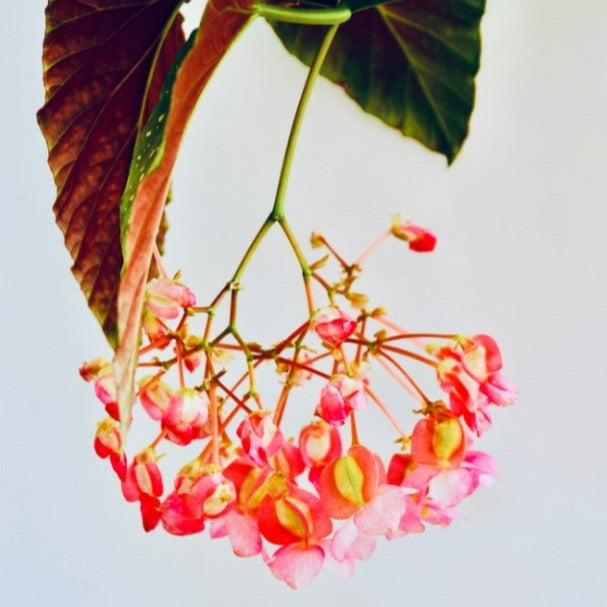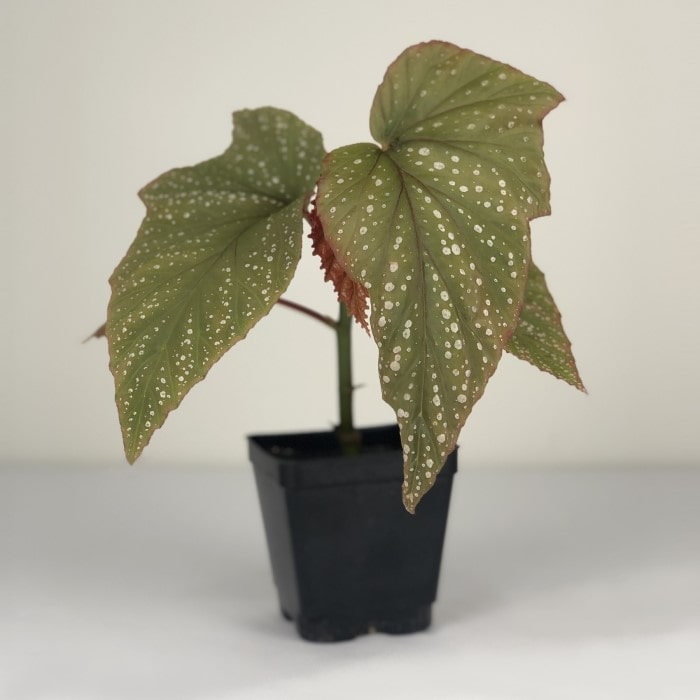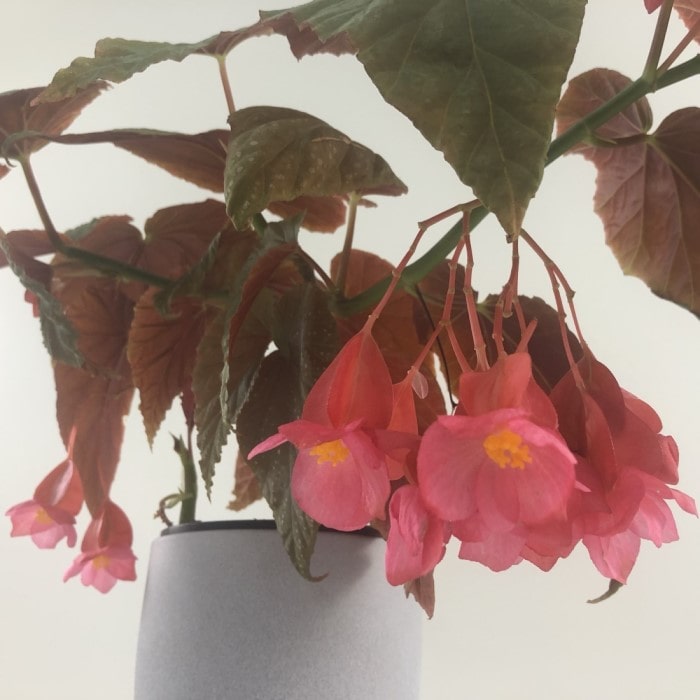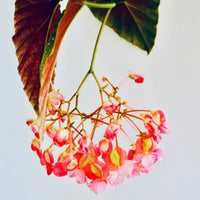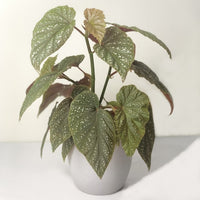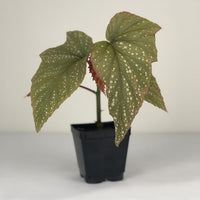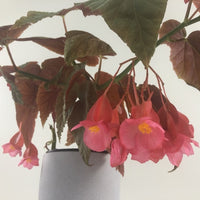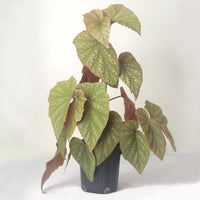Begonia x corallina
Overview
Uses: Houseplant, patio plant, or outdoor plant (in approved tropical zones)
Benefits: Unique and stunning foliage and flowers. Easy to take care of.
USDA Hardiness Zones: 10 - 12
Sun: Bright indirect to partial shade. Avoid strong, full sun. A minimum 4 hours of bright indirect sun daily is suggested.
Life Cycle: Perennial
Mature Height: 5' (easily kept shorter with trimming)
Mature Width: 2' (easily kept less with trimming)
Bloom Season: Possibly all year. Intermittent depending on lighting.
Summary
The Angel Wing Begonia is a gorgeous and popular houseplant—well known for its cane-like stems, beautiful spotted leaves, and magnificent flowers.
It's the perfect indoor plant for a wide variety of locations due to its potential variation in size (depending on its pot size and pruning schedules).
Easier to grow than many other plants, this Begonia thrives in areas that provide high humidity and lots of bright, indirect sunlight.
It can also be placed in areas that are more on the shadier side of things, although it will likely not flower in such a situation.
Care
How to Water an Angel Wing Begonia
We suggest watering an indoor Begonia x corallina twice a week. Avoid overwatering and do not allow this houseplant to rest in standing water. Too much watering will result in the yellowing of canes and leaves, eventually followed by root rot should the wet conditions persist.
This plant is not highly drought resistant and too little water for too long will initially result in drooping, followed by the browning of branches and eventual death.
How Much Humidity Does an Angel Wing Begonia Like?
Begonia x corallina loves high humidity and it's suggested to keep them in areas of humidity greater than 70% RH. They will not thrive if they are kept in areas that are too dry.
Although the plant prefers humid environments, it does not tolerate misting (which can cause fungal/rot issues).
Humidity should be supplemented by the use of a pebble tray or humidifier if the plant is kept in dry environments.
How Much Sun Should I Give my Angel Wing Begonia?
Avoid placing Begonia x corallina in areas that receive extended periods of direct sunlight.
The best lighting is provided by bright indirect light as direct light could fade the desirable silver leaf spots and cause leaf burn.
Angel Wing Begonias often do best in areas where they receive a slight amount of morning sun, followed by exposure to bright indirect sun and afternoon shade.
Brighter locations will encourage blooming and shadier locations will encourage vibrant leaf growth.
What Temperature is Best for Angel Wing Begonia?
Begonia x corallina prefer warmer temperatures and will likely die in prolonged temperatures of 50°F or cooler.
It's best to keep this plant in temperatures above 55°F to ensure its beauty and the integrity of its growth; however the optimal temperature range of this houseplant is between 65°F and 85°F.
This plant thrives outdoors year round in USDA zones 10-11, and may or may not survive living outdoors over winter in USDA zone 9.
What Soil is Best for Angel Wing Begonia?
Begonia x corallina aren't too picky when it comes to their soil, with the only real suggestion being that their soil be well-draining and in the neutral to acidic PH range.
Our potting soil is a great, all-around option that Angel Wing Begonias seem to love.
What Fertilizer is the Best for Angel Wing Begonia?
We suggest fertilizing your Angel Wing Begonia on a bi-weekly to monthly basis from early spring through late fall.
They don't require too much fertilization over the winter months, especially when in cooler environments with limited light.
Fertilizing should be done using a balanced liquid fertilizer, fish emulsion, or our slow release fertilizer.
How to Trim and Maintain an Angel Wing Begonia
Begonia x corallina can be pruned in various ways to encourage different growth patterns. Up to two/thirds the length of a cane may be cut off at a time. When taking a cutting, it's suggested to make the cut just above a node.
A bushy plant can be grown by trimming or pinching new growth from the tips of the canes, which will signal the plant to sprout lower shoots and also result in the division of the cut cane into two.
A lengthier, less bushy plant can be obtained by pinching or trimming lower branches to encourage the extended growth of existing canes. This pruning should be done using a sharp and clean set of pruning shears to ensure a clean cut and to mitigate the spread of disease. We suggest lightly fertilizing after pruning.
How to Repot an Angel Wing Begonia
Begonia x corallina like being mildly rootbound so its only suggested that you repot your plant if absolutely necessary and if the plant is not in flower.
You can repot your Angel Wing Begonia by placing the entire root ball into a larger pot then softly breaking up its root structure around the edges of its root ball prior to surrounding it with a lightly packed, medium porosity potting mix.
It's advised to only slightly increase the pot size when repotting.
How to Propagate Angel Wing Begonia
The propagation of Begonia x corallina is easily accomplished by placing a cutting in a glass of water, possibly with a slight amount of liquid fertilizer and/or rooting hormone (although neither are necessary).
It's best to provide propagation cuttings with ample light, but to keep them out of strong, direct sun.
It's also advisable that the cutting be freshly snipped at a slight angle just below the lowest node, and stripped of all leaves other than a few at the top prior to its submersion in water.
Size
What Size Angel Wing Begonias are for Sale Online?
The Begonia x corallina that we sell online will ship in a greenhouse grade grow pot. Each plant will be appropriately sized for its pot. Please contact us with any specific questions.
How Big Do Angel Wing Begonia Plants Grow?
Begonia x corallina are known to be both a great plant for your desk and for the corner of a room as they are quite versatile in size due to the fact that their size depends on their pruning.
They usually max out at about 2 feet of width and 5 feet of height.
Additional Information
Common Names of Begonia x corallina
-
Angel Wing Begonia
-
Begonia 'Lucerna'
-
Angel Wing Plant
A General Description of Angel Wing Begonia
The Angel Wing Begonia is a type of perennial flowering shrub from the popular genus of plants known as Begonia. This type of cane begonia is known for its beauty and ease of care.
This fast growing begonia gets its name from and can be identified by its cane-like stems that produce angel wing shaped lush leaves which are uniquely dotted with spots. Given proper light and fertilization rich in phosphorus, these plants will produce flowers featuring magnificent pink, waxy blossoms that drape downward and have yellow eyes. Flowering usually occurs multiple times from early spring through late fall, and they have been known to bloom year round if given the proper environment.
Both the intensity and growth rates of the leaves and flowers are very dependent on temperatures and the amount and strength of light this plant receives. High light levels and warm temperatures promote blossoms, while low light levels will encourage leaf growth. If flowers are pale in color it’s a good indicator that the plant is not receiving enough sunlight as they will deepen with more light. The best lighting is provided by bright indirect light as direct light could fade the desirable silver leaf spots and cause leaf burn.
The History of Angel Wing Begonia
Begonias are native to Brazil and other tropical climates. They gained their worldwide fame and distribution after people such as the former governor of French Canada, Michael Begon (1638-1710), began to adore them for their ornamental value. This led to Begoniaceae, the family of large flowering plants of which Angel Wing Begonias belong, being named in his honor.
This particular type of Angel Wing Begonia known as Begonia x corallina is a hybrid type of begonia which was created in 1926 after the successful hybridization of the Begonia aconitifolia and the Begonia coccinea by the famous plant breeder, Eva Kenworthy Gray.
The Toxicity and Risks of Angel Wing Begonia
Begonia x corallina is known for its toxicity to both people and to pets.
Vomiting, diarrhea, excessive salivation, abdominal pain, kidney failure, and/or death can occur after the ingestion of this plant's sap—which contains needle-shaped crystals of calcium oxalate called raphides (known to cause kidney stones in humans).
Allergic dermatitis (skin inflammation) and swelling of the skin can occur after repeated skin exposure to this sap.
The tubers and canes of this plant contain the highest concentrations of toxic sap.

